There is nothing easier than buying a bouquet in a specialized store and placing it in a vase or other vessel . But such flowers are devoid of individuality, your warmth is not invested in them, there is no part of your soul. It is better if you know the rules for composing bouquets, do it yourself. This is the only way to express your individuality. In addition, when composing a composition, you can choose flowers based on your preferences, and taking into account the mood at the moment.
Floristry: arranging beautiful flower bouquets
Already in ancient times, people used flowers for witchcraft and curing diseases – bunches of wild flowers and medicinal plants were installed in crevices of stones, hung in dwellings. But mankind did not remain indifferent to the beauty of flowers. On the frescoes of the Palace of Knossos in Crete, dating back to the II century. BC e., you can see the earliest image of roses in Europe. carved in stone roses are preserved in the monuments of Assyria and Babylon.
In ancient Judea, roses and white lilies were especially loved.
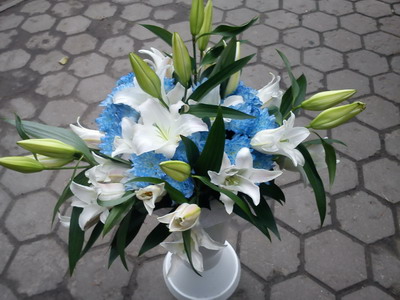
Tulips , hyacinths , daffodils , violets , and poppies were cultivated in the gardens of Iran. In ancient times, weaving wreaths and garlands of flowers was equated with art.

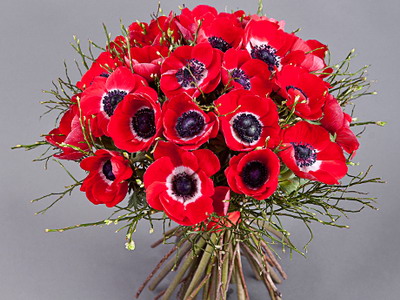
Drawing up bouquets of flowers is relevant both on holidays and on weekdays – they cheer up, decorate our lives.

They are a treat for the eyes and a balm for the soul. What heart does not warm up at the sight of cheerful flower heads swaying in a vase and giving smiles! It is difficult to imagine any event in the life of a person or society when it would be possible to do without flowers.
Bouquets decorate official meetings, honor anniversaries. Flowers are given to beloved actors and newly-made pensioners. Birthday, housewarming, dissertation or diploma defense, graduation party or just a gala dinner – flowers are appropriate everywhere.

Moreover, the bouquet can be not only an integral part of the gift, but also the gift itself.
Bouquet in French means a beautiful bunch of cut flowers. Bouquets first appeared in the 14th-15th centuries, replacing wreaths and garlands of fresh flowers. At the end of the same century, they began to be used as a gift.
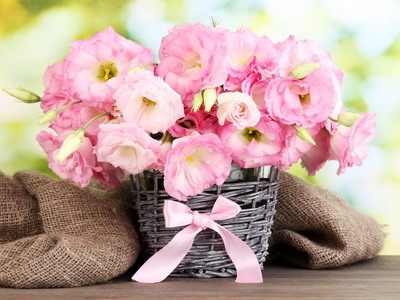
Self-composing bouquets of fresh flowers captivates an increasing number of people. The French word ” arrangement ” is taken from musical terminology and means the “orchestration” of flowers in accordance with the general purpose of the bouquet, the room, the vase.
Recently, a bouquet is increasingly called a composition, and it really differs from the traditional one. In floristry, arranging bouquets is not just a few cut flowers.
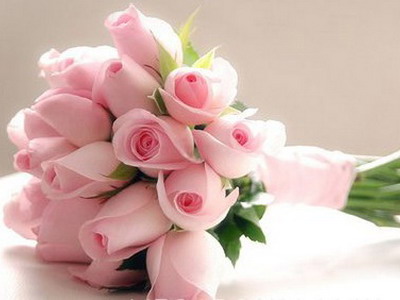
Preference is given to thematic compositions, where some colors play a leading role, while others only accompany them, creating a certain image and mood.
Japanese and European art of arranging bouquets
In the art of flower arranging, not so much knowledge and taste are important as talent. In Japan, arranging is called ikebana. The Japanese art of arranging bouquets is an ancient art that has grown from the national tradition of admiring flowers and has become an aesthetic ritual. It takes many years to understand it.

Watch the video of Japanese style bouquet making and enjoy the beauty of this ancient art:
The European arrangement has absorbed some of the features of this Oriental art.

Firstly, the composition of flower bouquets is a careful attitude to plants, the desire to bring out the beauty of each individual flower in the composition – “… one flower conveys splendor better than a hundred” (Yasunari Kawabata). Secondly, a careful selection of branches, herbs, leaves, helping to bring out the beauty of flowers. Thirdly, what we took from the Japanese is the ability to place plants as if they are growing on our table, and not necessarily in a vase, but in any saucer, on a tray, a piece of bark (the fantasy has no limits).
But do not unconditionally abandon our usual European bouquets.

Flower arrangement in European countries also has its own traditions, although not so ancient. A bunch of multi-colored garden irises in a transparent glass vase can cause no less delight than a refined ikebana.
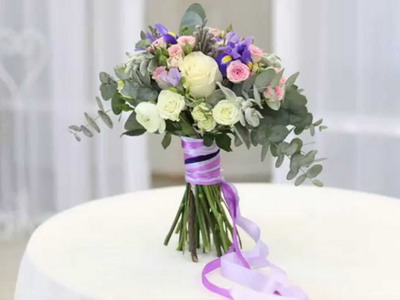
European bouquets are more natural, devoid of pretentiousness, and yet truly beautiful.
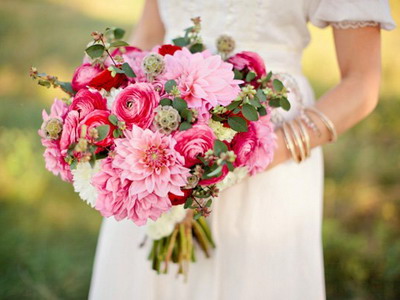
Here you can see a photo of European-style bouquets:
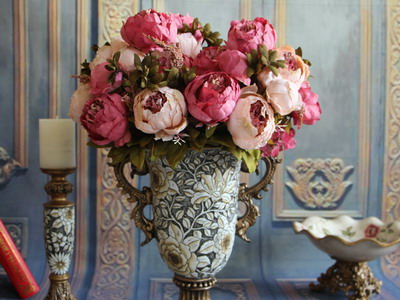
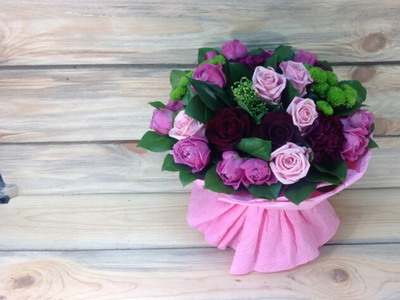
How many flowers should be in a bouquet and the correct proportions
And how many flowers should be in a bouquet, and are there clear rules on this? The number of flowers in a bouquet depends on their size, purpose of the bouquet and its size. To avoid symmetrical arrangement of flowers in small bouquets, use an odd number. Before making a bouquet of flowers, many turn to the magic of numbers: one flower – a sign of attention, three – respect, five – recognition, seven – adoration, nine – “I’m at your feet.” For mourning ceremonies, it is customary to make bouquets from an even number of plants. How many flowers in a bouquet of more than 10 flowers does not matter. In this case, the number can be either odd or even.
The art of arranging a bouquet is very interesting and exciting, it cannot have strict standards and ready-made recipes. Each person has an individual taste and manner, and when composing a bouquet, like nowhere else, complete freedom of creativity and imagination should appear.
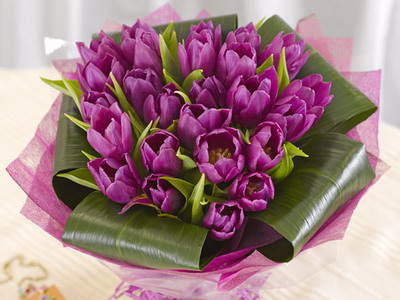
The guiding principles of any composition are the observance of the correct proportions between the individual parts and the whole, the vase and the bouquet, symmetry and asymmetry, line, shape, as well as scale – the ratio of the size of the bouquet to the surrounding room. Often, a vase is compared to a setting for a precious stone, which emphasizes its beauty.
Before composing a bouquet of fresh flowers, select the appropriate vessel: with its shape, color, size, the vase should fit both the flowers and the room. Vases can have very different shapes, but for a lush bouquet, expanding at the top is better, then the flowers will not crowd each other.

The narrow-mouthed vase is designed to hold multiple flowers, complemented by a beautifully curved branch. It is good to put several irises and two or three stalks of cattail in a tall narrow vase, which will help emphasize the connection between the seasons – autumn and spring.
When composing a bouquet with your own hands, you can choose a very small vase. Such a vessel with a modest bouquet would be appropriate on a work or dining table in a small room.
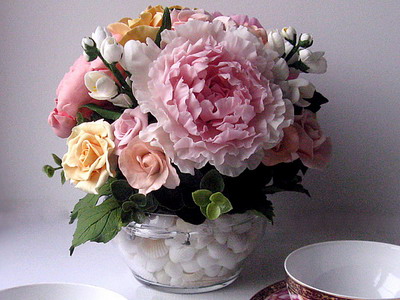
On a holiday, you can place a sprawling flower arrangement on a tray or flat dish on the table. Versatile is a neutral gray or brownish vase that suits a variety of colors and occasions.
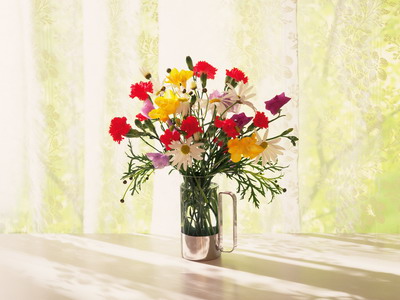
An important role is played by the ratio of the height of the flowers and the vase. The classic proportion: 1/3 falls on the height of the vase, and 2/3 – on the flowers.
In these photos of making bouquets of flowers, you can see compositions with classic proportions:


The combination of flowers and photos of beautiful bouquets
One of the main expressive means of arrangement is color and color combinations. There are a huge number of colors in nature, and they affect a person in different ways, causing various associations.
When combined in a bouquet of yellow flowers , a joyful mood is created, red-orange color excites, green soothes, blue is conducive to reflection.

Since ancient times, each element of the color spectrum corresponds to a certain concept: yellow – jealousy, orange – the sun, carmine – struggle, purple – dignity, purple – mysticism, blue – faith, electrician – desire, green – calmness, white – eternity, black – mourning , gray – poverty.
For most peoples, yellow and orange tones have always been associated with the sun and were perceived as joyful and life-affirming. However, some tones of yellow (gray-yellow, greenish-yellow) have become a symbol of envy, falsehood, treason.
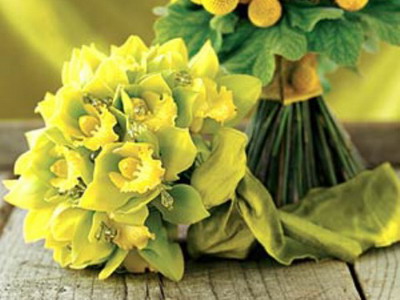
But in nature, such unpleasant shades are quite rare. Therefore, it is not necessary to refuse, as some do, generally from yellow flowers. Russians have long had a favorite color red, even the word “beauty” has the same root. Red is a symbol of freedom, love, holiday. If in European countries the color of mourning is black, then in many eastern peoples it is white.
A beautiful combination of flowers in a bouquet can be obtained based on astrological principles. Astrologers believe that every person unconsciously feels his own color.
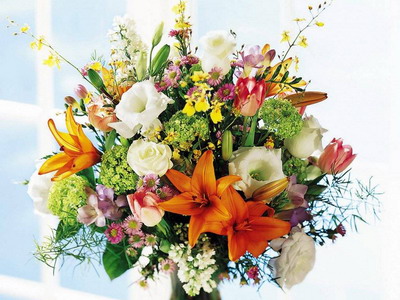
We may like pink because it suits us better, or turquoise, which is fashionable this season, but everyone has the color of the soul, the zodiac sign, which has the power of a talisman.
Aries prefers red.

Taurus is light green.
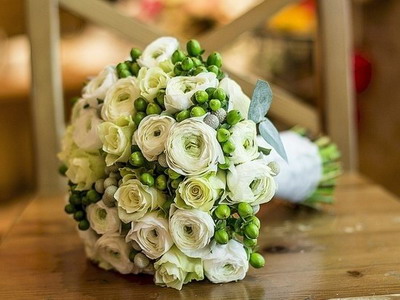
Cancer is blue.

Leo likes shades from orange to golden.
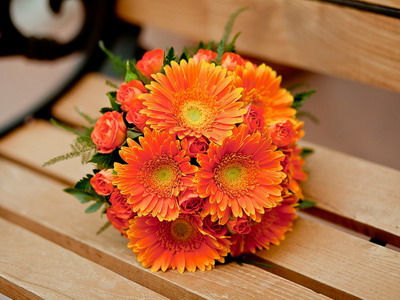
Pisces – all the nuances of blue-green.

Virgo – blue.

Libra – dark green.

Scorpio – purple.

Gemini, like Sagittarius, likes all the colors of the spectrum.

Capricorn is much stricter in his choice – he prefers white, black, purple.
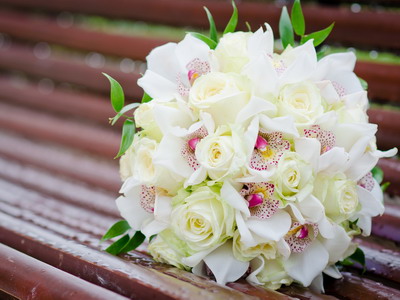
Aquarius’s favorite color is purple.
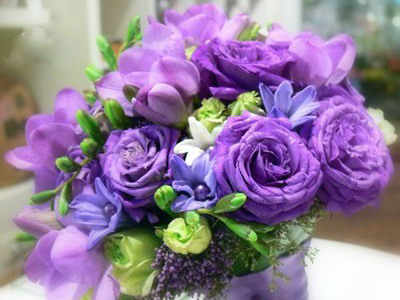
Even before you correctly compose bouquets of fresh flowers, consider what flowers of what shape and color are suitable for each other. The combination of colors in a bouquet can be pleasing to the eye or, conversely, annoying. Here, nature itself often gives a hint. For example, contrasting colors harmonize in pansies – lilac and yellow.
The combination of yellow and purple, orange and blue, green and red looks spectacular in bouquets.
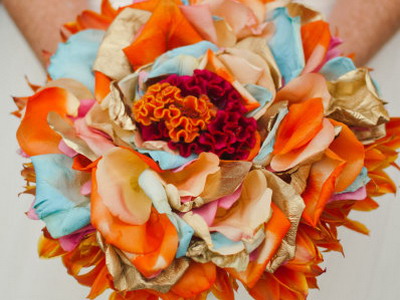
If, when composing a beautiful bouquet of red and blue plants, add white , a feeling of freshness will appear.
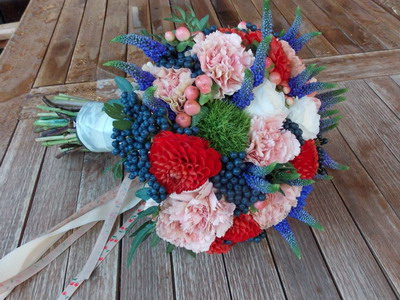
Blue and light green connect yellowish and pink tones.
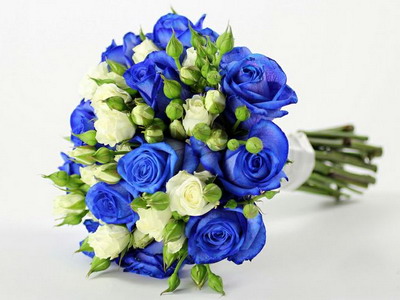
Brown among yellow and red gives the impression of sunspots. Especially elegant combination of delicate pastel colors.

If the two colors do not match, green leaves or discreet white flowers will help soften the dissonance. Ornamental grasses, easily swaying above the heads of flowers, adorn the bouquet very much. Sprigs of gypsophila and asparagus will enliven the “prim” bouquet.
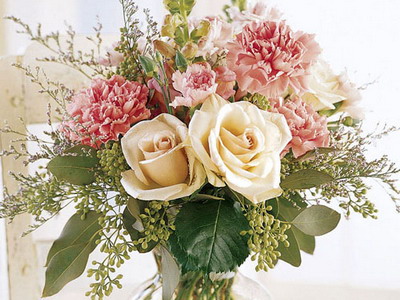
Pay attention to the photo of the combination of flowers in the bouquet – plants in the same bunch should not be discordant with each other:

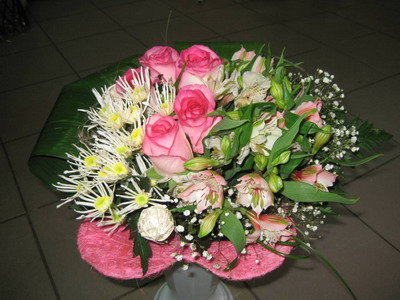
Rules for composing and arranging flowers in a bouquet
A free arrangement of flowers in a bouquet always looks more beautiful than a bulky close bouquet. The composition loses if the flowers are turned towards each other or drooped.
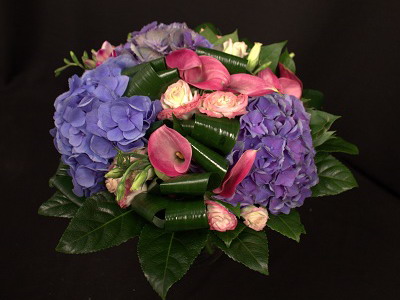
To make a bouquet, flowers and greens are pre-sorted according to the length of the stems and color. All kinds of additions (branches, leaves) should be in harmony with the flowers in color and structure. Having placed the flowers in the desired combination, they are fastened, and the ends of the peduncles are cut.
When composing a bouquet, you need to hold it vertically so that you can see it from all sides. A properly tied bouquet retains its shape when picked up by one stem. For bonding, soft material is usually used.

Bouquets are round and one-sided. A round bouquet is available for inspection from all sides. In the center, flowers are placed on long peduncles, slightly hanging along the edges, the stems should not be the same height. In a one-sided bouquet, flowers are placed in the background on long peduncles, and in front – on shorter ones. Just like in a round bouquet, a central spot is created from the most spectacular flowers.
It is very important to set the bouquet correctly. A round bouquet is often placed in the center of the table in a vase 15-20 cm high. If the bouquet is located against the wall, it is better to make it one-sided and place it in a higher vase. It is good to put 3-5 flowers with decorative greenery in a narrow tall vessel on a coffee table. A bouquet of 5-9 flowers would be appropriate on the dining table. A large decorative vase full of flowers is hardly suitable here. A more magnificent and solemn bouquet is selected for the festive table.
Another important rule for composing bouquets of flowers is to take into account their compatibility, since each plant releases metabolic products specific to it, which can be detrimental to other species.
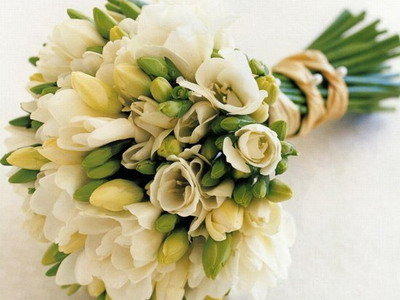
Cut daffodils have a detrimental effect on other flowers. Tulips in the same bouquet with them quickly fade. But if the daffodils are preliminarily kept for a day in cold water, they can be safely used in compositions with other flowers.

Fragrant flowers – lily of the valley, hyacinth – accelerate the wilting of other cut flowers, and it is not recommended to combine them in one bouquet.
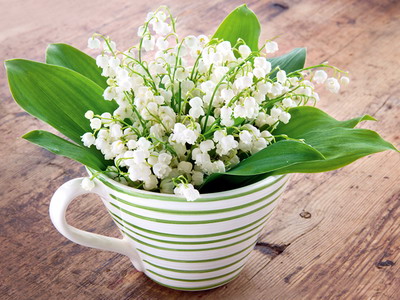
Yellow primroses should not be combined in a bouquet with other primroses , as well as with muscari . You can not put lilies of the valley and violets together: violets will quickly die. It has the same detrimental effect on violets and lilacs. Tulips and forget-me-nots in a bouquet with lilies of the valley are doomed to rapid fading.

However, some plants are not only compatible, but even have a beneficial effect on each other.
For example, tulips acquire a more intense color and last longer in the same vase with juniper or thuja branches.

A few sprigs of woodruff enhance the aroma of lilies of the valley and prolong their life.

Making bouquets of spring flowers (with photo)
There are no special requirements for the first bouquets of spring flowers. March and April compositions are usually light and laid-back. This is indeed the freest form of bouquets. Sometimes just a few spring flowers – fragrant violets or snowdrops – are enough to convey the joy of awakening nature. Such bright colors and juicy greenery will not be until next spring!
As you can see in the photo, spring bouquets of hyacinths are more refined:

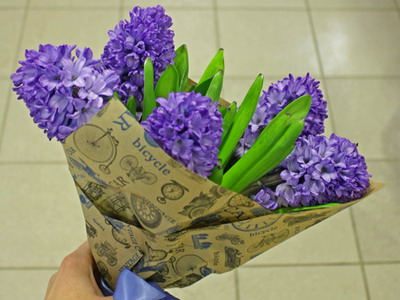
You can make a bouquet of several hyacinths with a delicate color of flowers (light pink, pale lilac, white), adding a bright red inflorescence for contrast.

In spring compositions, hyacinths are in harmony with daffodils and tulips, it is good to add a sprig of asparagus. Usually bouquets are set in low vases of neutral color.
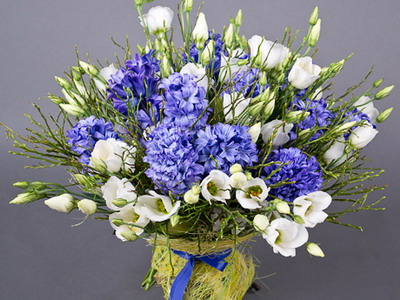
Daffodils delight us all spring. In bouquets they are placed freely, in small quantities. They look good in high and low vases with openwork greenery.
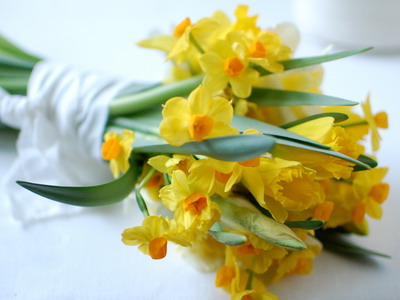
Before making a beautiful bouquet of these fresh flowers, cut off a few flowering branches of ornamental shrubs (willow, birch, alder or hazel with inflorescences), as well as green branches of cherries, plums or pears. Such compositions will look great in brown ceramics.
Nothing compares to the variety of shapes and colors that tulips give us. They are so bright and beautiful that they do not need the neighborhood of other colors.
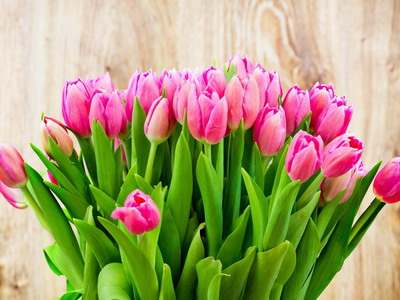
But if you add blooming shoots of forsythia, spirea, Japanese quince, terry Chinese plum to tulips and daffodils, then such a bouquet will make even an inveterate pessimist smile. Late tulips go well with lilacs.
In the photo of spring bouquets of flowers, you can see how simple and at the same time charming these compositions are:


How to make bouquets and photo compositions from natural flowers
Below you can learn how to beautifully arrange bouquets of flowers and provide plants with a long life in the cut.
Before properly composing a bouquet of flowers, the ends of the stems are cut off by 1-2 cm in order to restore their suction capacity.
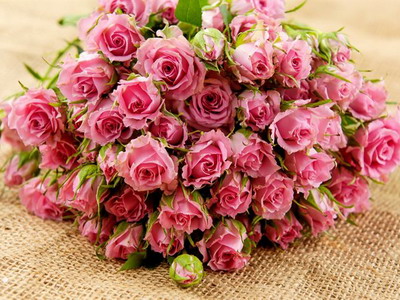
Cut or break off the stems should be under water. Excess leaves on the stem must be removed, as this will reduce the evaporation of moisture and improve the appearance of the bouquet.
Flowers last much longer in soft water – rain, snow, distilled. Tap water is preliminarily defended. Water temperature also matters. Preferred water with a temperature of 16-18 ° C, in summer – cold (6-8 ° C).

To inhibit microbes that are always present in water and cause rotting plants, water can be acidified with a copper or silver coin or by adding vinegar, citric or boric acid, and potassium permanganate. A very effective tool that prolongs the life of cut flowers is coniferous extract. It inhibits the development of bacteria, mold, so flower stalks can not be cut and change the water in the vase less often. 10 g of coniferous preparation and 50 g of sugar are added to 1 liter of water.
To revive slightly wilted flowers, the ends of the stems are dipped in hot water for a short time, and then kept in cold water in a cool room for 1-2 hours. The revitalizing effect of hot water on withered flowers is explained by the fact that the conductive vessels in the stems expand under the influence of heat, and the water begins to be absorbed by the plant again. Under the influence of hot water, the buds begin to bloom.
After looking at the photo, how to make bouquets of fresh flowers, you can create a beautiful composition:


How to correctly and beautifully make a bouquet of fresh flowers
The above recommendations are general for all colors. However, for individual cultures there are special secrets:
At the lilac, the ends of the branches are broken with a hammer and the bark is removed by 3-4 cm, all the leaves and side victories are removed, then placed in cold water.

At the iris, the stem is cut and put into the water as soon as possible, throwing a few ice cubes into it. Low water temperature promotes better flowering. You can add some sugar.
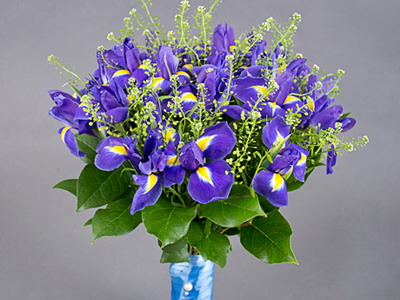
At a crocus , the end of the peduncle is dipped in alcohol.

Daffodils recommend not to cut, but to pluck in the phase of a colored bud.

To stop the secretion of milky juice, the stems are dipped in hot water (40-50 ° C) for a few seconds. To slow down the withering process, potassium permanganate, boric acid, aspirin are added to the water; sugar or salt (10 g / l) can be used. Useful daffodils frequent spraying with water.
The branches of trees and shrubs are dipped in vinegar or alcohol.
To make bouquets and flower arrangements, flowers are cut with a sharp knife close to the leaf node. The cut is made oblique so that water freely penetrates the stems. If the knife is blunt, the tissues of the stem crumple and hardly pass water. In order not to disturb the further development of the plant, when cutting, it is necessary to leave part of the shoot with leaves. Tulips suffer especially from improper cutting, they leave at least two leaves.
It is important to know in which phase it is best to cut flowers. In the phase of colored buds, a tulip, a narcissus are cut; with the first blooming flower in the inflorescence – iris ; in half-dissolution – anemone ; almost blooming – hyacinth, lilac.

It is recommended to cut flowers early in the morning or in the evening, when the plant contains the maximum amount of moisture, and immediately immerse the stems in water. It is advisable to keep cut flowers in a cool dark place for several hours at a temperature of 10-15 ° C and air humidity above 60-70%. Drafts are harmful to flowers.







